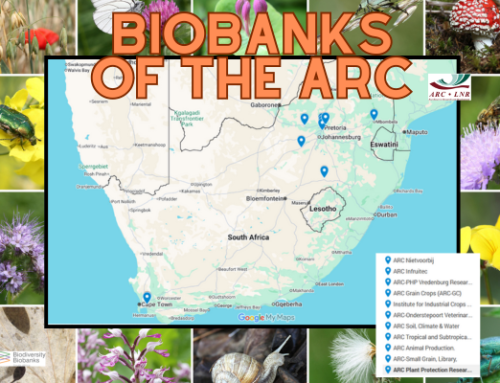Shared Wealth & Environmental Health: How Biobanking Benefits South Africa
It’s no secret that South Africa – like many other developing (and developed) nations – has its problems. Some of the big ones include poverty, food insecurity, energy availability, and – the big one – climate change. Can the Biodiversity Biobanks South Africa solve these challenges? Well, no – but it can help.

Professor Michelle Hamer
Project Lead: Biodiversity Biobanks South Africa (among other things).
“Biobanks are critical resources that are there to serve society in many different ways, from food security to conservation to understanding our world,” notes Professor Michelle Hamer, Director of the Biodiversity Biobanks South Africa (BBSA). “But biobanks need to be used – in an organised fashion, that benefits our country, and the broader research community.”
As one of the projects under the South African Research Infrastructure Roadmap (SARIR) of the Department of Science & Innovation (DSI), and administered by the South African National Biodiversity Institute (SANBI), the BBSA is a collaborative project – gathering together microbiologists, botanists, veterinary scientists and more who manage biobanks on university campuses, at dedicated research facilities, even at national parks, working on everything from bacteria to buffalo.

The BBSA is a network of biobanks that helps solve problems the only way we can: together.
But the effects of their work extend far beyond the research community – by providing a better understanding of South Africa’s biodiversity, they can help secure our future.
So how can biobanks help South Africa face our challenges? Let’s take a look.
- Better Biodiversity = Big Bucks: South Africa is known for its big game and other wildlife which attracts millions of tourists every year, boosting the economy and creating hundreds of thousands of jobs. But there’s more to the country than just the Big Five. South Africa is considered as one of the 17 most megadiverse countries globally, with not only exceptional species richness, but also exceptional levels of uniqueness (endemism), and biome and ecosystem diversity. And whether by land (SANParks Veterinary Wildlife Services Biobank) or sea (NRF-SAIAB aquatic biobank), whether they house plants (SANBI Indigenous Plant DNA Biobank) or fungi (ARC National Collection of Fungi), the BBSA biobanks help us preserve, conserve and understand this biodiversity – and the many employment opportunities and technologies that come with them.
- Food Security, Health & Wellbeing: Okay, so you can’t eat biobank samples (really – don’t even try). But the work conducted by biobank researchers can – and does – help promote food security. Biobanks under the custodianship of the Agricultural Research Council (ARC) include plant, animal and microbial-based assets on 11 campuses in all 9 of South Africa’s provinces. Along with the Department of Agriculture, Land Reform and Rural Development’s Biobank for Sheep & Goats and the National Plant Genetic Resources Center , these biobanks provide materials for use in improved crops, livestock and soil fertility, conservation and production of indigenous crops and other food sources, as well as conservation of pollinators. They also provide materials for research and development related to conservation and sustainable use of medicinal plants.
- Combating Climate Change: Sure, biobanks can’t directly solve climate change – they can’t magically take carbon dioxide out of the atmosphere or stop extreme climate events; and actually, running biobanks uses a fair amount of energy (keeping samples safe and monitored at ultra-low temperatures isn’t easy). But biobanks can help us understand the effects of climate change on species through time, and help us develop crops and domesticated animals that are resistant to the effects of climate change. And microbial biobanks like those at the Institute for Microbial Biotechnology (IMBM) can actually help produce biotech breakthroughs that can provide alternative energy sources like biofuels or can help us understand how microbes can survive (and alter) hotter and drier environments.
- Thinking Local, Acting Global: Some problems are too big for one country to tackle alone. But as a new member of the Global Genome Biodiversity Network (GGBN), the Biodiversity Biobanks South Africa can help researchers around the world access South Africa’s vast biodiversity resources – and help find answers to some of our most critical questions, from food security to conservation (and more). And the BBSA also recently joined the International Society for Biological and Environmental Repositories (ISBER), which provides members with opportunities for online training and access to an online biobank assessment tool, as well as other opportunities for learning and networking. And by thinking local and acting global, the BBSA helps promote sustainability the world over.
Of course, the work is never done.
“We still have a lot of work to do,” Prof Hamer notes. “We do also need to look at innovation and increasing the use of biobanks for addressing socio-economic and conservation issues, and dealing more directly with our many challenges. They may seem impossible now…but as we celebrate Mandela Day this month, it’s worth reflecting on this quote from a great South African: ‘It always seems impossible until it’s done’. Let’s get it done.”
Want to know more about the BBSA’s member institutions? We’ve got you covered. And while you’re at it, why not learn more about what biobanks are (and aren’t) all about?

What are biodiversity biobanks?
Biodiversity biobanks are repositories of biologically relevant resources, including reproductive tissues such as seeds, eggs and sperm, other tissues including blood, DNA extracts, microbial cultures (active and dormant), and environmental samples containing biological communities….






